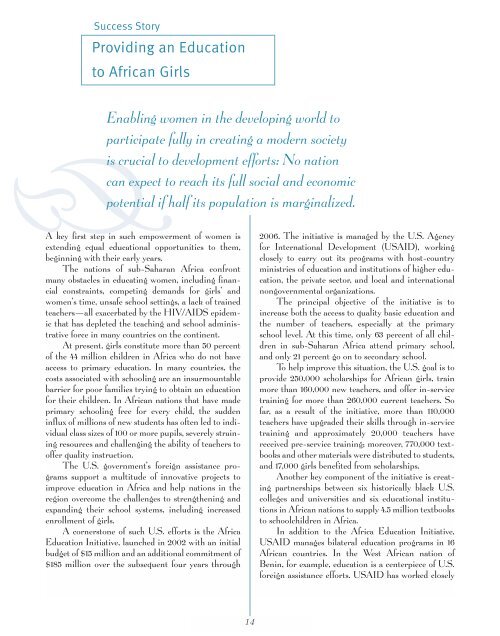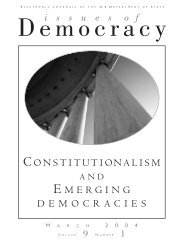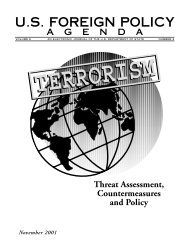Working for Women Worldwide - Embassy of the United States
Working for Women Worldwide - Embassy of the United States
Working for Women Worldwide - Embassy of the United States
Create successful ePaper yourself
Turn your PDF publications into a flip-book with our unique Google optimized e-Paper software.
Success Story<br />
Providing an Education<br />
to African Girls<br />
Enabling women in <strong>the</strong> developing world to<br />
participate fully in creating a modern society<br />
is crucial to development ef<strong>for</strong>ts: No nation<br />
can expect to reach its full social and economic<br />
potential if half its population is marginalized.<br />
A key first step in such empowerment <strong>of</strong> women is<br />
extending equal educational opportunities to <strong>the</strong>m,<br />
beginning with <strong>the</strong>ir early years.<br />
The nations <strong>of</strong> sub-Saharan Africa confront<br />
many obstacles in educating women, including financial<br />
constraints, competing demands <strong>for</strong> girls’ and<br />
women’s time, unsafe school settings, a lack <strong>of</strong> trained<br />
teachers—all exacerbated by <strong>the</strong> HIV/AIDS epidemic<br />
that has depleted <strong>the</strong> teaching and school administrative<br />
<strong>for</strong>ce in many countries on <strong>the</strong> continent.<br />
At present, girls constitute more than 50 percent<br />
<strong>of</strong> <strong>the</strong> 44 million children in Africa who do not have<br />
access to primary education. In many countries, <strong>the</strong><br />
costs associated with schooling are an insurmountable<br />
barrier <strong>for</strong> poor families trying to obtain an education<br />
<strong>for</strong> <strong>the</strong>ir children. In African nations that have made<br />
primary schooling free <strong>for</strong> every child, <strong>the</strong> sudden<br />
influx <strong>of</strong> millions <strong>of</strong> new students has <strong>of</strong>ten led to individual<br />
class sizes <strong>of</strong> 100 or more pupils, severely straining<br />
resources and challenging <strong>the</strong> ability <strong>of</strong> teachers to<br />
<strong>of</strong>fer quality instruction.<br />
The U.S. government’s <strong>for</strong>eign assistance programs<br />
support a multitude <strong>of</strong> innovative projects to<br />
improve education in Africa and help nations in <strong>the</strong><br />
region overcome <strong>the</strong> challenges to streng<strong>the</strong>ning and<br />
expanding <strong>the</strong>ir school systems, including increased<br />
enrollment <strong>of</strong> girls.<br />
A cornerstone <strong>of</strong> such U.S. ef<strong>for</strong>ts is <strong>the</strong> Africa<br />
Education Initiative, launched in 2002 with an initial<br />
budget <strong>of</strong> $15 million and an additional commitment <strong>of</strong><br />
$185 million over <strong>the</strong> subsequent four years through<br />
2006. The initiative is managed by <strong>the</strong> U.S. Agency<br />
<strong>for</strong> International Development (USAID), working<br />
closely to carry out its programs with host-country<br />
ministries <strong>of</strong> education and institutions <strong>of</strong> higher education,<br />
<strong>the</strong> private sector, and local and international<br />
nongovernmental organizations.<br />
The principal objective <strong>of</strong> <strong>the</strong> initiative is to<br />
increase both <strong>the</strong> access to quality basic education and<br />
<strong>the</strong> number <strong>of</strong> teachers, especially at <strong>the</strong> primary<br />
school level. At this time, only 63 percent <strong>of</strong> all children<br />
in sub-Saharan Africa attend primary school,<br />
and only 21 percent go on to secondary school.<br />
To help improve this situation, <strong>the</strong> U.S. goal is to<br />
provide 250,000 scholarships <strong>for</strong> African girls, train<br />
more than 160,000 new teachers, and <strong>of</strong>fer in-service<br />
training <strong>for</strong> more than 260,000 current teachers. So<br />
far, as a result <strong>of</strong> <strong>the</strong> initiative, more than 110,000<br />
teachers have upgraded <strong>the</strong>ir skills through in-service<br />
training and approximately 20,000 teachers have<br />
received pre-service training; moreover, 770,000 textbooks<br />
and o<strong>the</strong>r materials were distributed to students,<br />
and 17,000 girls benefited from scholarships.<br />
Ano<strong>the</strong>r key component <strong>of</strong> <strong>the</strong> initiative is creating<br />
partnerships between six historically black U.S.<br />
colleges and universities and six educational institutions<br />
in African nations to supply 4.5 million textbooks<br />
to schoolchildren in Africa.<br />
In addition to <strong>the</strong> Africa Education Initiative,<br />
USAID manages bilateral education programs in 16<br />
African countries. In <strong>the</strong> West African nation <strong>of</strong><br />
Benin, <strong>for</strong> example, education is a centerpiece <strong>of</strong> U.S.<br />
<strong>for</strong>eign assistance ef<strong>for</strong>ts. USAID has worked closely<br />
K<br />
14












